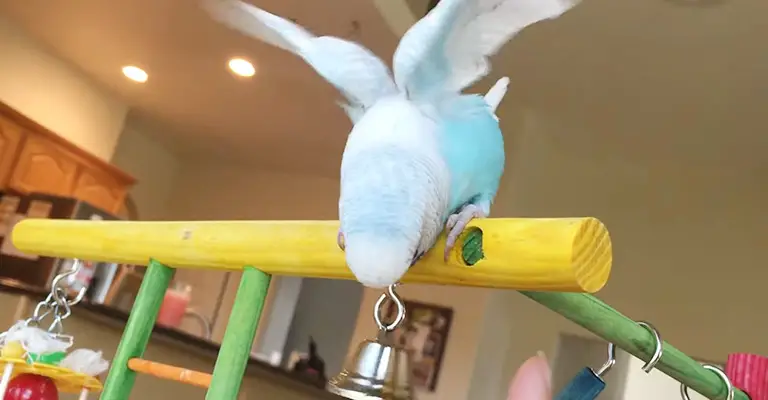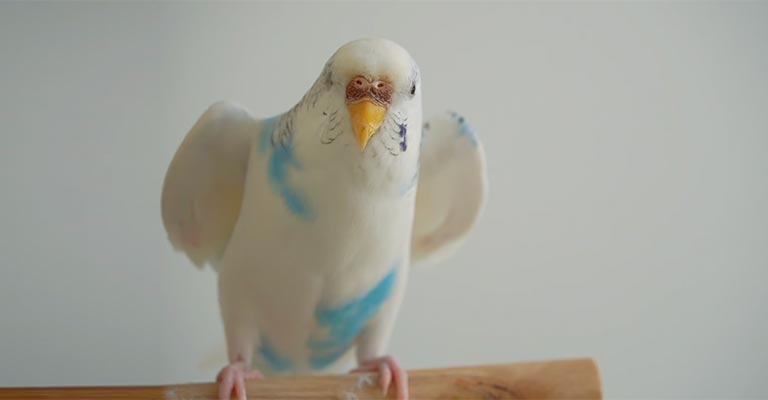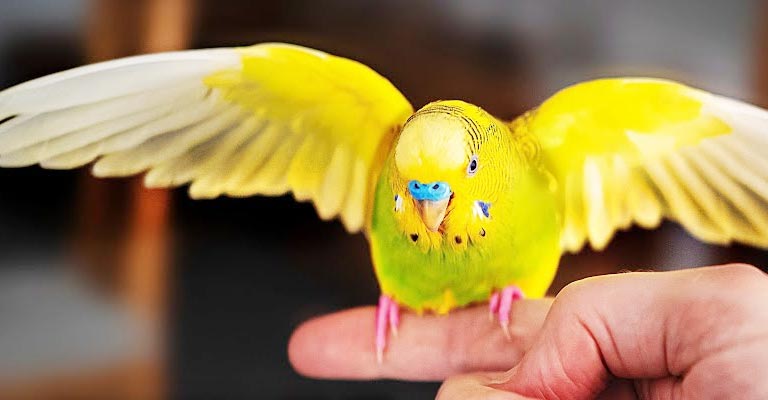Parakeets, also known as budgies, are small, colorful parrots that are popular as pets. They have a wide range of behaviors, including singing, talking, and playing with toys. One behavior that is often observed in parakeets is wing flapping.
This can be normal behavior as they stretch their wings or get exercise, but it can also indicate something more serious.
The purpose of this blog post is to explore the reasons why a parakeet may flap its wings really fast, and what it might indicate about their health and well-being.
We will also discuss what steps can be taken to address this behavior and ensure that your parakeet is living in a healthy environment.
This post will help parakeet owners understand their pet’s behavior and take appropriate actions to address any issues that may arise.

Reasons for Fast Wing Flapping
Fast-wing flapping in birds and insects serves several important purposes, depending on the species and its ecological niche.
Here are some of the main reasons for fast wing flapping
Showing Off/seeking Attention
Parakeets are social animals and may flap their wings quickly to get their owner’s attention. This behavior may also be a display of excitement or happiness. In this case, it is usually accompanied by other signs of contentment such as singing or preening.
Cooling Down
Parakeets have a unique way of regulating their body temperature. They pant to release heat and may also flap their wings rapidly to help dissipate heat. This behavior is more likely to be seen on hot days or in a room that is too warm.
Attempting to Fly
Parakeets have a natural urge to fly, and if they are confined to a cage, they may flap their wings quickly as a way of expressing their desire to fly. This behavior may also be seen if a parakeet’s wings have been clipped.
Distress and Aggression
Fast wing flapping can also be a sign of distress or aggression. This behavior may be accompanied by other signs such as puffing up of the feathers or biting. This behavior may occur if the bird feels threatened or is in pain.
In conclusion, fast wing flapping can have multiple reasons, it’s important to observe the bird’s environment, diet, and other signs to understand the reason behind the behavior.
Factors That May Contribute to Fast Wing Flapping

Clipped Wings
Clipping a parakeet’s wings limits its ability to fly and may cause them to flap its wings quickly as a way of expressing its desire to fly. When a bird’s wings are clipped, it can also cause them to become overweight, which can lead to weak or atrophied wing muscles.
Lack of Freedom
Parakeets are active birds that need room to fly and play. If they are confined to a small cage or lack space, they may flap their wings quickly as a way of expressing their desire for more freedom. This can also cause them to become bored and stressed, which can lead to other behavioral problems.
Improper Diet
An improper diet can lead to a variety of health problems in parakeets, including weak or atrophied wing muscles. A diet that is high in seeds and low in fruits and vegetables can lead to malnutrition and a lack of essential vitamins and minerals that are necessary for healthy wing muscles.
Weak or Atrophied Wing Muscles
Weak or atrophied wing muscles can also be a cause of fast wing flapping. This can occur as a result of a lack of exercise, a poor diet, or an injury.
If a bird’s wing muscles are weak, it may flap its wings quickly in an attempt to build strength. This behavior may be accompanied by other signs of weakness, such as difficulty flying or landing.
In summary, there are several factors that can contribute to fast wing flapping in parakeets, including clipped wings, lack of freedom, improper diet, and weak or atrophied wing muscles.
It’s important for parakeet owners to understand these factors and take steps to address them in order to ensure that their bird is living in a healthy environment.
How to Address Fast Wing Flapping?

Addressing fast wing flapping in your pet parakeet is essential to ensure its well-being and identify any underlying issues.
Here are steps you can take to address fast wing flapping
Provide a Healthy Environment
Providing a healthy environment for your parakeet includes ensuring that they have enough space to fly and play, as well as providing proper lighting, temperature, and humidity. This will help to reduce stress and promote overall well-being.
Allow for Exercise and Freedom
Allowing your parakeet to exercise and have freedom is crucial to their overall well-being. This can include providing them with a large cage, a play gym, or allowing them to fly around the room for a certain period of time each day. This will help to strengthen their wing muscles and reduce the urge to flap their wings quickly.
Provide a Balanced Diet
A balanced diet is essential for maintaining the health of your parakeet. This includes providing a variety of fruits and vegetables, as well as a good quality pellet diet. A balanced diet will help to ensure that your bird is getting all the necessary vitamins and minerals for healthy wing muscles.
Consult a Veterinarian if Necessary
If you have been providing a healthy environment, allowing for exercise and freedom, and providing a balanced diet and your parakeet is still flapping its wings quickly, it is important to consult a veterinarian. They can help to determine if there is an underlying medical issue that needs to be addressed.
In conclusion, addressing fast-wing flapping in parakeets requires providing a healthy environment, allowing for exercise and freedom, providing a balanced diet, and consulting a veterinarian if necessary.
By understanding and addressing the underlying causes of this behavior, you can help to ensure that your parakeet is happy, healthy, and comfortable.
Fast Wing Flapping in Parakeets
| Reasons | Signs | Addressing the issue |
|---|---|---|
| Showing off/seeking attention | Excitement, happiness | Provide attention, toys, and activities |
| Cooling down | Panting, flapping in a warm room | Provide a cool environment, misting with water |
| Attempting to fly | Flapping in a confined space, Clipped wings | Provide a larger cage, and flight time, and consider unclipping the wings |
| Distress and aggression | Puffing up of the feathers, biting | Identify and remove the cause of distress, provide a peaceful environment, and consult a veterinarian |
| Weak or atrophied wing muscles | Difficulty flying, landing | Provide a balanced diet, allow for exercise and freedom, and consult a veterinarian |
FAQs
Normal wing flapping is usually accompanied by other signs of contentment, such as singing or preening. If your parakeet’s wing flapping is accompanied by other signs of distress, such as puffing up of the feathers or biting, it may be a sign of distress or aggression.
The ideal cage size for a parakeet is one that is at least 24 inches wide, 18 inches deep, and 24 inches high. This will provide enough room for the bird to fly and play.
It is not recommended to clip your parakeet’s wings yourself. This should be done by a professional, such as a veterinarian or an experienced bird groomer.
It may be possible to train your parakeet to reduce its wing flapping, but it is important to address the underlying causes, such as a lack of exercise or a poor diet. Consult a bird behaviorist or a veterinarian for guidance on how to train your parakeet.
No, it is not normal for a parakeet to flap its wings quickly while sleeping. If you notice your parakeet doing this, it may be a sign of a medical issue, such as a seizure disorder or a sleep disorder. Consult a veterinarian for an examination.
A parakeet that has had its wings clipped will not be able to fly as well as a parakeet with unclipped wings. Clipping a parakeet’s wings limits its ability to fly, but it may still be able to glide or hop around.
Conclusion
We have discussed the reasons why a parakeet may flap its wings really fast, and what it might indicate about its health and well-being.
We have also discussed the factors that may contribute to this behavior, such as clipped wings, lack of freedom, improper diet, and weak or atrophied wing muscles.
Furthermore, we have outlined steps that can be taken to address fast wing flapping, including providing a healthy environment, allowing for exercise and freedom, providing a balanced diet, and consulting a veterinarian if necessary.
Understanding the behavior of your parakeet is crucial to their overall well-being. By understanding why they flap their wings quickly, you can take steps to address the underlying causes and ensure that they are living in a healthy environment.
Additionally, understanding their behavior can also help you to form a stronger bond with your parakeet, and enjoy a better relationship with your pet.
For more information on parakeet behavior and care, there are a variety of resources available online, such as pet care websites, avian forums, and books on parakeet care.
It also recommends consulting with an avian veterinarian for more specific information and advice. Additionally, speaking with other parakeet owners can also be a valuable resource, as they can offer insight and advice based on their own experiences with their birds.